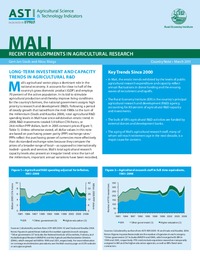Authors:
Stads, Gert-Jan; Maïga, Aliou
Year:
2011
Publisher
International Food Policy Research Institute (IFPRI); and Rural Economy Institute (IER)
Back to:
Although the political authorities have taken great pains to promote agricultural development during the past few decades, Mali’s R&D remains largely dependent on the support provided by donors and development banks, in particular through a series of projects led by the World Bank, the Netherlands government, and the Syngenta Foundation. During 2001–08, this dependence on short-term foreign aid projects combined with modest levels of public funding led to considerable annual fluctuations in both research expenditures and research capacity. It also brought financial uncertainty to the country’s R&D agencies. In 2008, Mali’s investments totaled approximately 5.9 billion CFA francs, or 24.6 million PPP dollars, both in 2005 constant prices and the country’s overall staff total stood at 313 FTE researchers (including the many contract researchers whose status differs from that of the state-employed “fonctionnaires”).
A number of donor-supported training programs played a crucial role in increasing IER’s number of PhD-qualified researchers, from 41 FTEs in 2001 to 61 FTEs in 2008. In the higher-education sector, the overall level of qualifications of the scientific staff also rose. At the time of writing, the average age of IER’s research staff exceeds the 50-year mark, notwithstanding the fact that many of its contract employees recently joined the pool of state employed researchers. In a few years from now, this reality will prove to constitute a major hurdle, as an increasing number of highly qualified and experienced researchers are due to retire. Recruiting and training young researchers is, therefore, a matter of utmost urgency if Mali wishes to maintain a critical mass of agricultural scientists.
In term of agricultural policies, several recent initiatives— such as the change of not only IER’s status but also that of its researchers, as well as the 2006 adoption of a framework law, LOA—leave room for hope that Mali’s authorities will be assigning an ever-higher priority to agricultural R&D. Nevertheless, as long as the national government is not committed to financing agricultural R&D in a more intensive and sustainable way, it remains to be seen whether Mali will succeed in leading a successful and effective battle against hunger and poverty.

